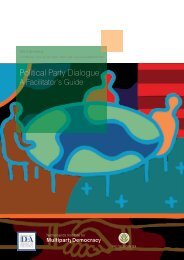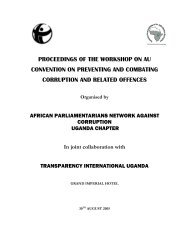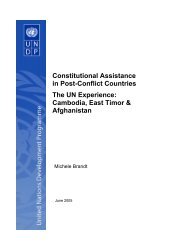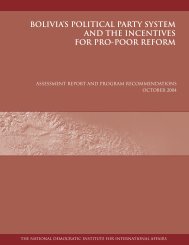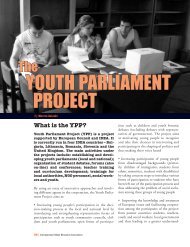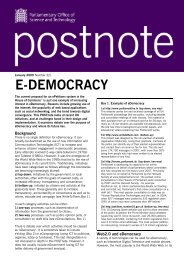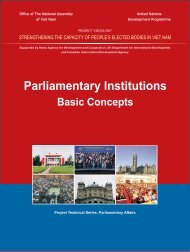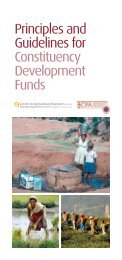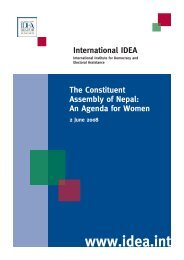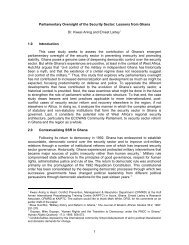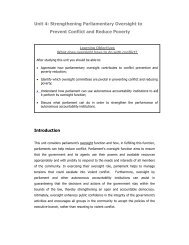One Size Does Not Fit All - International IDEA
One Size Does Not Fit All - International IDEA
One Size Does Not Fit All - International IDEA
- No tags were found...
Create successful ePaper yourself
Turn your PDF publications into a flip-book with our unique Google optimized e-Paper software.
<strong>One</strong> <strong>Size</strong> <strong>Does</strong> <strong>Not</strong> <strong>Fit</strong> <strong>All</strong>: Lessons Learned from Legislative Gender Commissions and Caucuses© <strong>International</strong> Institute for Democracy and Electoral Assistance© National Democratic Institute for <strong>International</strong> AffairsMarch 2010 Spanish EditionJune 2010 English Edition<strong>International</strong> <strong>IDEA</strong>Strömsborg SE-103 34,StockholmSwedenTel.: +46 8 698-3700Fax: +46 8 20-2422info@idea.intwww.idea.intAndean Region OfficeCalle Coronel Andrés Reyes 191San IsidroLima 27, PeruTel.: +51 1 440-4092Fax: +51 1 421-2055NDI2030 M Street, NWFloor 5Washington, D.C. 20036Tel.: 202-728-5500Fax : 202-728-5520contactndi@ndi.orgwww.ndi.orgNDI - MexicoParque España #59Colonia Condesa, Del. CuauhtémocMexico, D.F.Tel.: (5255) 52.12.18.04Fax: (2522) 10.84.74.85The publications of <strong>International</strong> <strong>IDEA</strong> and NDI do not reflect any specific national or political interest. The opinionsexpressed in this publication do not necessarily represent the views of these institutions, their boards of directors, themembers of their councils or donor agencies. aaaaaAAAAAAAAAAAAAAAAAAAAAAAAAAAAAAAAAAAAAAA<strong>All</strong> rights reserved. NDI and <strong>International</strong> <strong>IDEA</strong> encourage dissemination of their work and will grant requests toreproduce and/or translate this work for non-commercial purposes. AAAAAAAAAAAAAAAAAAAAAAAAAAAALayout and design: Ruperto Pérez-Albela StuartCover illustration: Anoli PereraEnglish translation: Barbara FraserPrinting: Tarea Asociación Gráfica EducativaFirst edition: June 2010Press run: 1000 copiesHecho el Depósito Legal en la Biblioteca Nacional del Perú: 2010-07012ISBN 978-91-85724-97-0Printed in Peru
AcknowledgementsThis guide is the result of interest by NDI and <strong>International</strong> <strong>IDEA</strong> in collaboratingon a document about best practices that would provide Latin American legislators withideas and experiences to help them organize and successfully promote a gender equalityagenda while they are in office. AAAAAAAAAAAAAAAAAAAAAAAAAAAAAAAaThis project was directed by Keila González, NDI Senior Program Officer, andKristen Sample, <strong>International</strong> <strong>IDEA</strong> Head of Mission for the Andean Region. AAAAWe thank the researchers who contributed detailed information about experiencesand best practices in their countries or made comments on the final draft: Jutta MarxSchutz (Argentina), Carolina Floru (Bolivia), Diana Espinosa (Colombia), Marcela JagerContreras (Costa Rica), Solanda Goyes (Ecuador), Begoña Lasagabaster (Spain), MarielaArce (Panama), Gloria Young (Panama), Rossana Andía (Peru), Beatriz Llanos (Peru),Niki Johnson (Uruguay) and Verónica Pérez Betancur (Uruguay). We are also gratefulto Alyson Kozma (NDI), Rocío Álvarez (NDI), and Lucila del Águila for research andediting assistance; María Inés Calle (<strong>International</strong> <strong>IDEA</strong> Latin America publicationscoordinator) for overseeing the book’s production; Andrew Mash for copy editing;Ruperto Pérez-Albela for his work on the layout and design; and Barbara Fraser fortranslating the original text from Spanish. AAAAAAAAAAaaaaaaaaaaaaaaaaaaaaaaaaAFinally, NDI and <strong>International</strong> <strong>IDEA</strong> thank the National Endowment for Democracy(NED) for financing the regional conference of congresswomen in Mexico and partof this publication, and the Spanish Agency for <strong>International</strong> Cooperation andDevelopment (AECID) and the Norwegian Ministry of Foreign Relations for theirassistance, without which the publication of this guide would not have been possible. a9
Table of ContentsPrefaceAcknowledgementsTable of contentsIntroduction591112CHAPTER I WOMEN WORKING TOGETHER IN PARLIAMENT: FORMS OFORGANIZATION1. Why do women organize in the legislature?2. What are the options?a. Commissions: purpose, structure, membership and operationb. Caucuses: purpose, structure, membership and operationc. A third wayd. A mixed model? The benefits of having a gender caucus even when a gendercommission exists3. Organization of collective work. How to achieve the best organizational structureCHAPTER 2 BEST PRACTICES: <strong>IDEA</strong>S FOR GENDER WORK ACROSS PARTY LINESChallenge: To establish consensus on issues and prioritiesChallenge: Developing viable, attractive proposals and advocacy within party caucusesChallenge: Ensuring the ability to create a social support base for the developmentand approval of proposalsChallenge: Mainstreaming gender in all legislative work and more broadly, in governmentpolicy and operations15151619202122242727282930ConclusionsBibliography<strong>Not</strong>esAppendixAbout NDIAbout <strong>International</strong> <strong>IDEA</strong>323437394143
IntroductionPolitical participation by all citizens, men and women, is essential for strengtheningdemocratic systems and institutions that claim to be inclusive and representative. AAAAlthough women make up 50 per cent of the world’s population, in the political spherethey remain under-represented as political leaders, party leaders, candidates and electedofficials. This under-representation is one of the main obstacles to a public agenda thataddresses issues of interest to women. AAAAAAAAAAAAAAAAAAAAAAAAAAANDI and <strong>International</strong> <strong>IDEA</strong> firmly believe that equitable participation by women inpolitics and government is essential for building and sustaining democracy. If democraticgovernments are to respond to citizens, they must betruly representative. This means recognizing that womenmust participate in democratic development processeson an equal footing with men. Women’s contributions‘In my experience, the fact thatI was a leader in congressallowed me to influence certainpieces of legislation and getthem onto the committees’daily or weekly agendas’.are crucial for building strong societies. aaaaaaaaaaaaaaa<strong>International</strong> norms, such as the Convention on theCentral American congresswomanSee IPU, Politics: Women’s Insight,Elimination of <strong>All</strong> Forms of Discrimination against2000, pp.30–315Women (CEDAW), the World Action Platform from6 7Beijing and the Quito Consensus, promote parity in representation of men and womenand highlight the role of legislatures in achieving the gender equity required of allsignatory states. aaaaaaaaaaaaaaaaaaaaaaaaaaaaaaaaaaaaaaaaaaaaaaaaaaaaaaaaaaaaaaaaaaIn Latin America, women hold 20 per cent of the seats in the lower houses of congressor unicameral legislatures. The process of increasing women’s representation has beenaccelerated in 12 countries by affirmative action measures, especially the use of electoralquotas.12
ONE SIZE DOES NOT FIT ALL: LESSONS LEARNED FROM LEGISLATIVE GENDER COMMISSIONS AND CAUCUSESGraphic 1: Percentage of women in parliaments (lower house or unicameral), February 201050%40%30%20%10%38.536.8 32.328.2 27.5 25.420.8 20.7 19.7 19.0 18.0 18.015.0 14.1 13.0 12.0 9.0 8.58.40%ArgentinaCosta RicaEcuadorMexicoPeruBoliviaLatin AmericaNicaraguaDominican RepublicEl SalvadorHondurasVenezuelaChileUruguayParaguayGuatemalaBrazilPanamaColombiaSource: See Inter-Parliamentary Union (www.ipu.org/wmn-e/classif.htm)The impact of women’s participation in various spheres of public life, especiallyparliament, has become increasingly evident in recent decades. Many examples fromacross the world show that women can help to ensure that politics are: AAAAAAAAMore representative, by introducing new issues and different perspectives.Although having more women in elected office does not guarantee that they willrepresent women’s interests, it is an essential first step. Gender issues or matters ofparticular interest to women, such as domestic violence, sexual and reproductiverights, non-discrimination in the workplace, and childcare policies, which havetraditionally been excluded or considered non-priority issues by male legislators,have found a place on legislative agendas through the efforts of women legislators,often with support from women’s civil society organizations. Studies in countriessuch as India, Norway and the United Kingdom have shown that increasing genderequality in government can lead to public policies that are more responsive to8women’s needs. Women have also promoted gender mainstreaming in key areas ofnational policy other than those traditionally considered women’s issues, such as peaceprocesses, arms control, financial regulation, the environment and economic policy.IntroductionMore democratic, by promoting laws that foster gender equality and serve as the basisfor the design of public policies that promote a culture that accepts and facilitateswomen’s empowerment. Prominent women can serve as models to encouragecitizens to take ownership of their rights and participate more actively in a country’spolitical life. Studies in the United Kingdom have shown that in districts withfemale representatives, women also seemed to be more active citizens, demonstrating9greater political interest and willingness to help in campaigns. aaaaaaaaaaaaaaaaaaaa13
ONE SIZE DOES NOT FIT ALL: LESSONS LEARNED FROM LEGISLATIVE GENDER COMMISSIONS AND CAUCUSESMore transparent, because, as some studies indicate, women can be particularly10effective at promoting openness and accountability in government. According toone analysis, data from several countries show lower levels of corruption when there11are more women in parliament. AAAAAAAAAAAAAAAAAAAAAAAAAAAAAThese concerns and an analysis of women’s contributions to building more effectiverepresentative democracies led us to re-examine the results of the regional conferenceof women parliamentarians, ‘Women Working Together: Promoting GenderMainstreaming in the Legislature’, as well as prior work undertaken by <strong>International</strong><strong>IDEA</strong> and NDI with women parliamentarians from different countries and existingstudies, to develop this guide and highlight the importance of defining mechanisms forcomparing and understanding what is happening in other countries. This guide has twogoals: to provide information about gender commissions and caucuses; and to serve as atool to help legislators, both male and female, implement best practices for promotinggender equality. It does not pretend to address all mechanisms for mainstreaminggender in parliaments or to serve as an academic study of commissions and caucuses. Onthe contrary, because one size does not fit all for such groups, the goal is to provideinformation and ideas about initiatives in which legislators have jointly promotedgender equality in their respective parliaments. AAAAAAAAAAAAAAAAAAAAAWe hope the best practices described in this guide will:AAAAAAAAAAAAAAAAAProvide more detailed information about establishing cross-party venues for dialogueand consensus building. aaaaAAAAAAAAAAAAAAAAAAAAAAAAAAAAAAAPromote discussion and reflection on best practices for the establishment andworking of gender commissions and caucuses. AAAAAAAAAAAAAAAAAAAAInspire legislators to use some of the best practices, adapting them to the needsand processes of their own parliament. AAAAAAAAAAAAAAAAAAAaaaaaaaAChapter 1 presents arguments for the organization and participation of women in crosspartylegislative venues and describes options for achieving this, highlighting experiencefrom Latin America and a few countries from other regions of the world. Chapter 2describes experiences and best practices related to gender commissions and caucuses,based on actual cases. AAAAAAAAAAAAAAAAAAAAAAAAAAAAAAAAAAAA14
Chapter 1WOMEN WORKING TOGETHER IN PARLIAMENT:FORMS OF ORGANIZATIONObjective: to provide descriptive information about different ways in which womenparliamentarians organize to advance their interests more efficiently. AAAAAAAAA1. Why do women organize in the legislature? AAAAAAAAAAAAAAAAAAAAAAAAs is noted in the introduction, it is important that there is a significant number ofwomen in the legislature, because they can influence the issues on the agenda and thedraft legislation that is presented. Nonetheless, the presence of women in the legislaturedoes not guarantee changes in the visions and practices of parliaments, which areinstitutions designed by men and which remain dominated by men in areas including12their structure and internal functioning. AAAAAAAAAAAAAAAAAAAAAAAAAAIn addition, in many Latin American countries, the number of women legislators remainstoo small to substantially or effectively change the agenda and dynamics of the legislature.This leads us to ask whether it is possible for women to bring about change in thelegislature even when they are a minority. How can women legislators have an impacton their parliaments, especially when they are few in number? AAAAAAAAAAAAResearch in various countries around the world show that major changes often dependon the collective efforts of parliamentarians who have decided to work together topromote specific reforms. At the same time, gender commissions and caucuses have13expanded their influence in many areas. When we refer to commissions, we mean thoseinstitutionalized legislative groups with functions that include detailed analysis of draftlegislation, proposing new policies and laws, issuing opinions and monitoring publicadministration. When we speak of caucuses, we refer to informal groups of womenlegislators who channel the women’s interests and concerns within parliament. Thesegroups have a variety of functions. AAAAAAAAAAAAAAaaaaaaaaaaaaaaaaaAAAACommissions and caucuses: AAAAAAAAAAAAAqqqqqqqqqqqqqAAAAAAAAAAaHelp define the issues on the political agenda and set priorities, carry out detailedanalysis of draft legislation and propose new policies and legislation. They raise publicawareness and keep citizens informed. AAAAAAAAAAAAAAAAAAAAAAAAA15
ONE SIZE DOES NOT FIT ALL: LESSONS LEARNED FROM LEGISLATIVE GENDER COMMISSIONS AND CAUCUSESFacilitate the participation of civil society organizations in the development of thepublic and political agenda. AAAAAAAAAAAAAAAAAAAAAAAAAAAAAAAAAct as a safeguard to ensure that affected groups and individuals are aware of anylegislation being debated that affects them; in particular, they are a visible andaccessible contact point for women on issues that affect them. AAAAAAAAAAAAMonitor compliance with legislation and executive branch actions on gender issues.The work of many gender caucuses goes beyond developing and promoting publicpolicies. They often sponsor programmes, meetings, activities and workshops to helpwomen in parliament become stronger political actors, acquire skills and legislateefficiently, understand and work within internal parliamentary rules, bring about changein male political cultures and practices, and build solidarity and gender awareness. Forexample: aaaaaaaaAAAAAAAAAAAAAAAAAAAAAAAAAAAAAAAAAAAAAAAThe Women’s Caucus of Uganda holds workshops for women delegates onspeechmaking, building a voter base, forging coalitions, parliamentary procedures14and related matters. AAAAAAAAAAAAAAAAAAAAAAAAAAAAAAAAAAAIn Morocco, the Parliamentary Women’s Network organized a workshop to train15participants on conflict resolution and negotiating techniques. AAAAAAAAAAAIn Uruguay, the Bicameral Women’s Caucus has held seminars on gender and genderbudgeting and has proposed ways to mainstream gender in reforms of criminaland procedural legislation. AAAAAAAAAAAAAAAAAAAAAAAAAAAAAAAAThe best-practices section of this guide provides more detail about these and otherinitiatives. AAAAAAAAAAAAAAAAAAAAAAAAAAAAAAAAAAAAAAAAAAA2. What are the options?AAAAAAAAAAAAAAAAAAAAAAAAAAAAAAAAAAAWomen in legislatures have found organizing across party lines to be useful for advancingissues of interest to them in parliament. Different experiences around the world showthat there is no single model of organization. Instead, there are multiple options forstructuring the cross-party venues for consensus building. AAAAAAAAAAAAAAAIn their broadest sense, cross-party forums of women legislators comprise a spectrumfrom formal, structured bodies, such as gender commissions, to informal, possibly lessstructured bodies, such as gender caucuses. Along the spectrum are many variedpermutations of ways to build consensus. AAAAAAAAAAAAAAAAAAAAAAAAA16
ONE SIZE DOES NOT FIT ALL: LESSONS LEARNED FROM LEGISLATIVE GENDER COMMISSIONS AND CAUCUSESAs Table 1 shows, the two models have common elements and differences. Forexample, commissions tend to be permanent and are part of the organic structure ofcongress, while caucuses, although they may be recognized by parliamentary leaders,are generally not part of the permanent structure of the legislature. AAAAAAAAAATable 1 Comparison of main characteristics of commissions and caucusesModelCharacteristicCommissionsCaucusesNaturePurposeStructureMembershipAttributesDecision-makingprocessesResourcesTend to be officially chartered bodies within theparliamentary structure. In many cases, theybegin as ad hoc commissions.Creation, promotion and oversight of legislativeframework to foster gender equality andchanges to guarantee more equitable conditionsfor women in all spheres of public and privatelife. Their influence on the work of otherparliamentary commissions is often limited.Replicate the structure established for congress:leadership or coordinating body, vice presidents,technical secretaries, and so on. The leadershipselection process may be subject to negotiationamong party caucuses.Cross-party venue. Membership tends to reflectthe make-up of congress. The possibility ofbeing a member depends on a decision by thelegislator’s party to join the commission, as longas the maximum number of members is notexceeded. Mainly women, but with a significantnumber of men.Generally has the power to present draftlegislation and monitor executive branch publicpolicies on gender equality; often reports onwhether a piece of legislation on gender issuesshould be approved.By majority, although consensus is generallysought.Has a budget allocated by congress, and anadministrative staff and infrastructure.Tend to be recognized by the legislature, althoughwith a different standing than a commission.Because they are established at the initiative oflegislators themselves, their continuity dependson having legislators who are committed to andvalue such structures.Formed to promote a gender equality agenda inthe legislature or to enhance the work of women incongress.Very diverse, depending on the criteria and bylawsestablished by each caucus. In its mostbasic form, there is usually a spokeswoman.Leadership and leadership selection processesare established internally.Cross-party and even multi-sector venue(including civil society). Formal membership maybe automatic or voluntary. Membership is open toall women in parliament. Men tend to participateless than in the commission model. In somecases, former women legislators are invited toparticipate.Depending on the structure, it may propose draftlegislation, although it may not necessarilyintroduce the legislation in the full legislature.Generally does not issue reports of the sort issuedby commissions.By majority or consensus.<strong>Does</strong> not have a set budget. Can establishmechanisms for obtaining contributions frommembers and may receive assistance frominternational organizations for activities.Women Working Together In Parliament: Forms Of OrganizationSource: compiled by NDI / <strong>IDEA</strong>.17
ONE SIZE DOES NOT FIT ALL: LESSONS LEARNED FROM LEGISLATIVE GENDER COMMISSIONS AND CAUCUSESIt should also be noted that in some countries, women’s or gender commissions beganas caucuses or special commissions. In Mexico, the Gender and Equality Commissionwas a special commission during two legislatures, until 2000, when it was established asa standing commission. In Uruguay, one of the first initiatives of the Bicameral Women’sCaucus was to request the creation of a Special Gender and Equality Commission inthe House of Representatives. Because the caucus was not part of the legislature’sinstitutional structure, the creation of a commission that would allow formal access tolegislative processes and channels for interaction and control, within parliament andin the legislative branch and other government bodies, was considered necessary. aaaThis does not mean that caucuses always result in the establishment of a gendercommission. In Ecuador, the Specialized Permanent Commission on Women,Children, Youth and the Family was dissolved in July 2009 but a Parliamentary Groupfor Women’s Rights was subsequently created to promote a gender agenda. In somecases, a caucus is formed even though a standing commission already exists inparliament. A gender caucus and a gender commission are neither mutually exclusivenor contradictory; they are complementary and act in accordance with their respectivestrengths and limitations. AAAAAAAAAAAAAaaaaaaaaaaAAAAAAAAAAAAAAATable 2 Comparison of commissions and caucuses, by countryCountry Type of Parliament Commission CaucusArgentinaBoliviaBrazilColombiaCosta RicaCubaChileBicameralBicameralBicameralBicameralUnicameralUnicameralBicameralChamber of Deputies: Commission on Family,Women, Children and AdolescentsSenate: Population and Human DevelopmentCommissionChamber of Deputies: Gender and GenerationalAffairs Committee iChamber of Deputies: Permanent Commission onSocial Security and Family iiSenate: Seventh Commission on the Public ServantStatute, Public Servant Wages and Benefits, TradeUnion Organizations, Social Security, Sports, Health,Housing, Women’s Issues and Family iiiChamber of Representatives: Seventh Commissionon the Public Servant Statute, Public Servant Wagesand Benefits, Trade Union Organizations, SocialSecurity, Sports, Health, Housing, Women’s Issuesand Family.Special Permanent Women’s Commission vCommission on Youth, Children and Equal Rights forWomen viChamber of Deputies: Family Commission viiWomen’s CaucusUnion of ParliamentaryWomen of Bolivia (Umpabol)Women’s CaucusAd hoc Commission onGender Equality, Social,Political and Labor Rights,Mental Health and Women’sSexual and ReproductiveHealth ivNoneNoneNone18
ONE SIZE DOES NOT FIT ALL: LESSONS LEARNED FROM LEGISLATIVE GENDER COMMISSIONS AND CAUCUSESCountry Type of Parliament Commission CaucusEcuadorEl SalvadorGuatemalaHondurasMexicoNicaraguaPanamaParaguayPeruDominicanRepublicUruguayVenezuelaUnicameralUnicameralUnicameralUnicameralBicameralUnicameralUnicameralBicameralUnicameralBicameralBicameralUnicameralNoCommission on Family, Women and Children viiiWomen’s Commission ixOrdinary Women’s Commission xChamber of Deputies: Gender and EqualityCommission xiSenate: Gender and Equality CommissionPermanent Commission on Women, Children, Youthand Family xiiiPermanent Commission on Women, Children’sRights, Youth and Family xivChamber of Deputies: Social Equality and GenderCommissionSenate: Permanent Equality, Gender and SocialDevelopment Commission xvWomen and Social Development Commission xviChamber of Deputies: Permanent Gender EqualityCommissionSenate: Permanent Commission on Family Affairsand Gender Equality xviiChamber of Deputies: Special Gender and EqualityCommission xviiiPermanent Family, Women and Youth Commission xixSource: Compiled by NDI and <strong>International</strong> <strong>IDEA</strong>.Parliamentary Group forWomen’s Rights (men andwomen)NoneWomen’s CaucusNoneBicameral CommissionWomen’s Parliament ofMexico xiiNoneNoneNoneRound Table of PeruvianParliamentary Women(MMPP)NoneBicameral Women’s CaucusA. Commissions: purpose, structure, membership and operations aaaAAAAAAAAAAParliamentary commissions are institutionally established working groups that areresponsible for debating and providing information about draft legislation or otherproposals submitted to them. Traditionally, commissions were established toaddress thematic areas set out in the internal constitution or rules of a country’sparliament. aaaAAAAAAAAAAAAAAAAAAAaaaaaaaaaaaaaaaaaaaaaaaaaaaaaaaaAA(BBF)NoneWomen Working Together In Parliament: Forms Of OrganizationThe roles of commissions vary somewhat from country to country. The main onesinclude: aaaAAAAAAAAA aaaAAAAAAAAAA aaaAAAAAAAAAAAAAAAAA— Reporting on laws and proposing legislative initiatives. aaaAAAAAAAAAAAAAA— Legislative oversight to ensure accountability, which may include the power to callministers or other government officials to appear in parliament, to convene publichearings, and to offer critiques and alternative proposals. aaaAAAAAAAAAAAAAA19
ONE SIZE DOES NOT FIT ALL: LESSONS LEARNED FROM LEGISLATIVE GENDER COMMISSIONS AND CAUCUSES— A budget for the commission’s activities may be established, based on its work plan. AIn the past decade, commissions have been created by Latin American parliaments toaddress gender issues. The name varies from country to country. As Table 2 shows, insome countries they are called women’s commissions, in others they are gendercommissions and in others such issues are addressed in commissions on the family andchildren. aaaAAAAAAAAA aaaAAAAAAAAAAAAAAAAAAAAAAAAAAAAAThe work of the commissions mainly focuses on specific legislation on women’s issuesand, to a lesser extent, the adoption of gender equality criteria in other legislation. Theseparliamentary bodies have varied tasks and there is no single pattern or role. In general,they not only focus on drafting legislation and proposing reforms to current legislation,but also analyse bills presented by legislators, propose modifications to their content orwording and provide information about them to the full parliament. They also developcontacts with the political and social sectors affected by such laws. There is a steadilyincreasing awareness in civil society of the important role played by these commissions,16and civic groups often approach them with suggestions. aaaAAAAAAAAAAAAAAAAUnlike gender caucuses (with some exceptions, such as Ecuador), commissions tendto include men. According to a report published in 2008 by the Inter-Parliamentary17Union, which includes a survey of 93 gender and women’s commissions worldwide,among 50 per cent of the commissions that address gender issues, approximately 50per cent of the members are men. aaaAAAAAAAAAAAAAAAAAAAAAAAAAAAAB. Caucuses: purpose, structure, membership and operationsaaaAAAAAAAAAAAAIn some countries, female legislators and women who are active in politics have chosena model that is less formal than a gender commission. Like commissions, gendercaucuses are cross-party venues for consensus building, but they usually do not fallunder the legislature’s internal rules. Often legislators who decide to form a gendercaucus can determine its structure, decision-making mechanisms, integration, operationand specific areas of activity. aaaAAAAAAAAAAAAAAAAAAAAAAaaaaaaaaaAAThis flexibility has resulted in the creation of varied examples of working models. InColombia or Uruguay, for example, the caucus is bicameral and includes all titular femalelegislators in both houses, while Argentina has a unicameral Senate caucus. aaaAAAAThe Parliamentary Women’s Caucus of Malawi has a president, vice president andprogramme officers for each sub-committee, while the Parliamentary Women’s Forum20
ONE SIZE DOES NOT FIT ALL: LESSONS LEARNED FROM LEGISLATIVE GENDER COMMISSIONS AND CAUCUSESof Morocco has only a president and representatives of the agencies from which it iscomposed. In Peru, the Round Table of Peruvian Parliamentary Women (Mesa de MujeresParlamentarias Peruanas, MMPP), created in 2006, consists of women legislators from allparliamentary party groups and they elect the group’s president annually. In Uruguay,the Bicameral Women’s Caucus is a horizontal coordinating body without formalofficers, although informally designated legislators serve as its spokespersons. AAAMembership can also be highly diverse. The examples mentioned above are of caucusesthat consist exclusively of women legislators, but others, such as the Association ofParliamentary Women of Uganda, allow men to participate as honorary members. Thesame is true in Ecuador, where the Parliamentary Group for Women’s Rights consistsof male and female legislators, and has a coordinating group made up of seven femalelegislators and one male legislator. The Political Women’s Caucus of Indonesia and theNetwork of Parliamentary Women and Civil Society in Afghanistan include not onlywomen in parliament, but also representatives of civil society organizations, whilethe Association of Women Legislators and Former Legislators of El Salvador(Asociación de Legisladoras y ex Legisladoras de El Salvador, ASPARLEXSAL) includesboth past and present women parliamentarians. The same is true of the Associationof Parliamentary and Former Parliamentary Women (Asociación de Parlamentarias y exParlamentarias, APARLEXPA) in Panama. aaaAAAAAAAAAAAAAAAAAAAAAAThese examples indicate that the structure and scope of a caucus are determined byits members. aaaAAAAAAAAA aaaAAAAAAAAAA aaaAAAAAAAAAAAAAAAC. A third wayAlthough this guide focuses on commission and caucus models, there is a third modelfor promoting women’s participation and influence in the legislative branch ofgovernment. In Sweden, for example, legislators have rejected the idea of creating astructure specializing in gender and equality issues. This rejection was based on theperception that commissions or caucuses act as ‘ghettoes’ that marginalize women’sinterests by formally complying with the legislature’s obligation to include gender, butdo not necessarily ensure in practice that initiatives receive thorough, integral treatment18or that gender is mainstreamed in legislation. aaaAAAAAAAAAAAAAAAAAAAAAWomen Working Together In Parliament: Forms Of OrganizationInstead, the Swedish Parliament has chosen to mainstream gender in all parliamentarycommissions. Gender equality issues were gradually assigned to specific parliamentarycommissions, such as the Health and Welfare Commission or the Justice Commission,21
ONE SIZE DOES NOT FIT ALL: LESSONS LEARNED FROM LEGISLATIVE GENDER COMMISSIONS AND CAUCUSEStaking into consideration each issue and the commission to which the activitiescorrespond. This practice is not, however, formally established in the rules of theSwedish Parliament. aaaAAAAAAAAA aaaAAAAAAAAAAAAAAAAAAAAAAAAAlthough this model has some advantages, it also poses risks, because it depends greatlyon the presence of women and men with high levels of gender awareness and thenecessary skills for including the gender perspective and analysis in legislative proposals.Gender mainstreaming may be lost or diluted when many proposals are under discussion,especially if it competes with other priority areas. Analysis of the conditions in whichthe Swedish model emerged reveals that specialized commissions were less necessarybecause of the high percentage of women (47 per cent) in the Swedish Parliament and19the country’s long history of progress on gender issues. aaaAAAAAAAAAA aaaaaaa<strong>One</strong>, still incipient, example in Latin America is the Ecuadorian National Assembly’sLegislative Technical Unit. During the restructuring of the legislature, it was decidedthat a Women’s Commission was no longer necessary because it made gender a separateissue instead of mainstreaming it. To mainstream gender in all legislation, and to takeinto account the large number of women in the National Assembly (32 per cent), manyof whom are committed to gender issues, the decision was made to create a permanenttechnical unit to report on the gender impact of all legislation introduced in parliamentand review the language used in the legislation to ensure that it is not discriminatory.The unit’s reports are technical and non-binding, and the unit consists of experts ratherthan legislators. aaaAAAAAAAAAA aaaAAAAAAAAAA aAAAAAAAAAAAAAAD. A mixed model? The benefits of having a gender caucus even when a gendercommission exists aaaAAAAAAAAAA aaaAAAAAAAAAA aaaAAAAAAAAAAAOnce a legislative branch has a body with certain constitutional and regulatory powersfor promoting a gender equality agenda, the question of whether women legislatorsalso need other cross-party consensus-building avenues arises. aaaAAAAAAAAAAThe experiences of Uruguay and Peru indicate that a gender caucus adds value to thework done by commissions, especially when effective mechanisms for coordinationbetween the two groups exist. In the Uruguayan Parliament, the five female legislatorswho participate in the Special Gender and Equality Commission are also active membersof the Bicameral Women’s Caucus, which enables them to promote initiatives on whichconsensus has been built within the caucus. aaaAAAAAAAAAAAAAAAAAAAAAA22
ONE SIZE DOES NOT FIT ALL: LESSONS LEARNED FROM LEGISLATIVE GENDER COMMISSIONS AND CAUCUSESExperiences from Latin America and other regions indicate that caucuses cancomplement the efforts of a gender commission, adding value by: aaaAAAAAAAAA1. Facilitating frank and direct communication among women legislators, transcendingpartisan interests, especially on draft legislation related to women’s rights andsocial policy. AAAAAAAAAAAAAAAAAAAAAAAAAAAAAAAAAAAAAAAA2. Creating a forum for addressing the discrimination that most women legislators facebecause of their gender. aaAAAAAAAAaaAAAAAAAAAAAAAAAAAAAAAAA3. Facilitating gender mainstreaming by including and gaining the support of womenwho do not serve on the commission. aaAAAAAAAAaaAAAAAAAAAAAAAAA4. Making women more visible as a group, both within parliament and in the public eye.This can be an excellent way to facilitate assistance and training for any womenlegislators that may have less experience on gender issues, through workshops onuseful tools for legislative work, round-table discussions on issues of national interest,or mentoring programmes. This provides an opportunity to ‘pass on the torch’ orensure the continuation of the work of outgoing women legislators. aaaAAAAA5. Offering greater autonomy and freedom, as more flexible forums than commissionsallow the members to develop less constrained work and dialogue dynamics thanthose established by internal parliamentary rules. aaAAAAAAAAAAAAAAAAA6. Facilitating the establishment of networks, which can include civil society20organizations, since they are not bound by the internal rules of parliament. aaAAAA7. Promoting the development of a joint agenda on issues around which consensushas been built, so legislators can support them in their own commissions. aaAAAAThere are examples from Latin America of the benefits of having a parliamentary groupof women. In Brazil, for example, the women’s caucus often votes as a bloc. By doing so,it has promoted legislation to establish a gender quota for candidacies in all officessubject to proportional representation and a law on violence against women. The caucushas also mobilized to ensure that the Brazilian budget included funds for socialprogrammes and gender equality initiatives. It played a decisive role in ensuring that the1988 Brazilian Constitution included women’s rights, through a provision known as21the ‘lipstick clause’. aaAAAAAAAAAAAAAAAAAAAAAAAAAAAAAAAAAAAAWomen Working Together In Parliament: Forms Of OrganizationIn Uruguay, the Bicameral Women’s Caucus worked from 2000 to 2002 to approve a lawagainst domestic violence and a law that would allow all Uruguayan women to take a day22off from work for their annual gynaecological exam. In Colombia, the joint effortsof the Women’s Caucus and grassroots women’s organizations, along with thecommitment and support of other women in parliament, was crucial to winningapproval for a comprehensive law on women’s right to a life without violence. AAAAA23
ONE SIZE DOES NOT FIT ALL: LESSONS LEARNED FROM LEGISLATIVE GENDER COMMISSIONS AND CAUCUSES3. Organization of collective work: How to achieve the best organizational structure aaaAs demonstrated above, collective work ranges from structured formats to much moreflexible forums. Although the more formal structures may facilitate efficientmanagement of gender issues in parliament, through commission functions that rangefrom promoting initiatives to monitoring government actions, the flexibility offered bygender caucuses allows women in the legislature to determine the model that is mostuseful and productive for them. Regardless of the format that is chosen, however, certainfactors should be considered when establishing a parliamentary women’s group: AAA1.2.3.Determine the mission, vision and goals. Whether it is part of a formal commissionor an informal caucus, it is important that the legislators have a common vision andmission, common goals and a shared view of the work they expect to do together toadvance the gender equality agenda. For a legislative gender caucus, these definitionsshould be established at the beginning of the process of establishing the group. Inthe case of a commission, this discussion will take place once the members aredetermined, so they can establish a common agenda. For example, in 2006, in theGender and Equity Commission of the Mexican Chamber of Deputies, after a highlycompetitive electoral process the women legislators presented their issues of interestto their party caucuses and then decided to work together based on points ofconsensus, such as gender-sensitive budgets or guarantees for women in the armedforces. aaaAAAAAAAAAAAAAAAAAAAAAAAAAAAAAAAAAAAAAAAAAAnalyse the political implications. It is necessary to consider the political contextand how it will affect or be affected by the group’s structure. It is also important toanalyse how other legislators and political and social stakeholders will perceive thegroup, taking into account the group’s diversity and representation. AAAAAAAADefine internal work dynamics. <strong>One</strong> key factor in the consolidation of the group is aclear definition of internal rules for its work, including such aspects as frequencyof meetings, selection and rotation of leadership, decision-making processes andtheir implementation, designation of spokespersons, and so on. AAAAAAAAAAAIn Costa Rica, the Women’s Commission of the Legislative Assembly works byconsensus. Advisers to the commission members work together beforehand to ensurethat the members can approve draft legislation by consensus. In Peru, the Women andSocial Development Commission develops an annual work plan establishing its goalsand the issues to be addressed during the legislative session. It meets once a week, all thelegislators on the commission participate, and other legislators interested in the day’sagenda can speak but not vote. aAAAAAAAAAAAAAAAAAAAAaaaaaaaaaaaAAAA24
ONE SIZE DOES NOT FIT ALL: LESSONS LEARNED FROM LEGISLATIVE GENDER COMMISSIONS AND CAUCUSESIn Uruguay, the Bicameral Women’s Caucus works on the basis of a concept of ‘unity’and has no officers or internal hierarchy. The position to be taken on gender issues isbased not on consensus, but on respect for the differences and constraints of eachmember within the framework of a shared conviction, with the goal of placing theseissues on the legislative agenda for discussion. This strategy has enabled the caucus toovercome challenges that could have caused division, such as the presentation ordiscussion of draft legislation on issues including quotas or abortion, about which allmembers do not agree. aAAAAAAAAAAAAAAAAAAAAAAAAAAAAAAAAAAAIn Malawi, the caucus meets at least once during each legislative period, on the firstWednesday of the session, but the caucus president can call additional meetings. Whenthe legislature is not in session, the president can also call a meeting with the approval ofother members. With support from NDI, the caucus completed plans for its structureand surveyed its members about potential priority areas. Those identified by the surveywere widows and inheritance, child support and custody, and marriage and divorce.These results allowed the caucus to focus on the issues that were most important to its23members and to reach consensus on issues. AAAAAAAAAAAAAAAAAAAAAAAATo give women in Nepal more opportunities to reach leadership positions, presidents ofthe Women’s Caucus are elected for one-year terms. The caucus president and vicepresident cannot be from the same party. Other elected officers include the secretary,treasurer and public relations officer. The Nepali caucus does not have a legislative ormeeting agenda because its members have decided not to focus on developing proposalsfor legislation. NDI has assisted the caucus with seminars and programmes to help the24caucus members develop their skills and their voter base. AAAAAAAAAAAAAAAVarious countries have cross-party groups of women legislators that help strengthen thepresence and voice of women in legislative bodies. There are also multi-sector groups inwhich representatives of civil society organizations participate, giving the legislatorsmore contact with citizens and issues of interest to them.Women Working Together In Parliament: Forms Of OrganizationThe Parliamentary Forum of Women of Rwanda has five governance structures. TheGeneral Assembly is the highest-ranking and includes all women legislators in theforum. The Executive Committee consists of nine women legislators and is responsible forforum management. The third structure consists of five Permanent Committees:women’s empowerment and capacity building; advocacy and association with othergroups; gender and legislation; monitoring of public policy; gender strategies and budget;and research, documentation and technology. The fourth structure is the Auditing25
ONE SIZE DOES NOT FIT ALL: LESSONS LEARNED FROM LEGISLATIVE GENDER COMMISSIONS AND CAUCUSESCommittee, which consists of three women legislators who are responsible for theforum’s financial affairs, ensuring that the decisions of the General Assembly areimplemented, and resolving conflicts that may arise within the forum. The last structure25is the Executive Secretariat, which is responsible for day-to-day forum management. AAIn Finland, where there had not previously been a formal women’s caucus in parliament,in 1991 women legislators established the Network of Women Deputies of theParliament of Finland. There has always been cooperation among women inthe legislature, and the network has given this greater structure. It organizes seminarsand meetings and coordinates cooperation with legislators from other countries.The network’s activities are managed by an executive committee elected annually by theGeneral Assembly. Each party caucus is also represented in the network by oneexperienced women legislator and one newly elected representative. The president andvice president of the network hold their positions for one year, and their selection26rotates among the party caucuses. aAAAAAAAAAAAAAAAAAAAAAAAAAAAaAIn Uruguay, women legislators in the Bicameral Women’s Caucus maintain close ties withthe Network of Political Women, a cross-party coordinating group of active womenparty members who hold office at all levels of the political system. In 2009, theyorganized a conference with the women elected to participate in their parties’ nationalconventions. This cooperation has been crucial for raising awareness among womenpoliticians who are not necessarily committed to gender issues, building their capacitiesas political stakeholders, and developing common visions of the country’s politicalagenda on gender equality. AAAAAAAAAAAAAAAAAAAAAAAAAAAAAAAAAaAlthough there are many and diverse experiences of women’s commissions andcaucuses, it is possible to identify best practices that have allowed them to overcomeobstacles that might have derailed their activities. These are discussed in chapter 2. AA26
Chapter 2BEST PRACTICES:<strong>IDEA</strong>S FOR GENDER WORK ACROSS PARTY LINESObjective: To propose best practices that enable women legislators to overcomeobstacles and more effectively promote gender mainstreaming in the legislature. AAACHALLENGE: TO ESTABLISH CONSENSUS ON ISSUES AND PRIORITIESABEST PRACTICESAAAAAAAAAAAAAAAAAAAAAAAAAAAAAAAAAAAAAThe Network of WomenDeputies in the FinnishParliament organizesinformative luncheons to fosterdebate in parliament aboutimportant current issues.Cabinet ministers aresometimes invited to theseevents.Foster personal relationships among women leaders ininformal and social venues (such as conferences, activities,workshops, etc.). aaaAAAAAAAAAAAAAAAAAAAAReactivate the agenda established by the signing or ratificationof international conventions and commitments.Gender commissions or similar bodies should help ensureenforcement of CEDAW and use it to raise awareness andestablish gender equality legislation. Women legislators can also identify discrepanciesbetween legal commitments and the implementation of such laws and policies, throughoversight of international norms such as CEDAW and the Quito Consensus. AAABase debate on research and concrete data, whichimplies agreeing on the sources of information to beused and seeking technical advisers to provide theseinputs for political dialogue. aAAAAAAAAAAAAAAEstablish internal mechanisms and procedures tostreamline communication among members, decisionmaking and consensus building. AAAAAAAAAAAADefine procedures for scaling up the discussion ofissues.When election conflict eruptedbetween two of the three mainpolitical forces in Mexico in 2006,the Gender and EquityCommission decided not to carrythe conflict over into its work, andits members devoted severalsessions to defining a commonagenda based on issues onwhich the different partiesagreed, establishing that noissue tied to ideological positionswould be taken before thecommission.Define the range of action for the body, agreeing to table issues or initiatives thatare strongly tied to ideological or partisan positions. AAAAAAAAAAAAAAAAAA27
ONE SIZE DOES NOT FIT ALL: LESSONS LEARNED FROM LEGISLATIVE GENDER COMMISSIONS AND CAUCUSESWhile the Namibian Parliament’s Gender Commission addresses gender issues from a partisan politicalperspective, the Women’s Caucus plays the essential role of analysing, from a general perspective that setsaside political differences, issues such as the budget, CEDAW and its implications for legislation, women’s rights,and oversight of enforcement of laws on gender issues. The group presents proposals and makes collectivestatements in the name of women, and disseminates information about relevant legislation to the public. aaSee IPU, “Women in National Parliaments”CHALLENGE: DEVELOPING VIABLE, ATTRACTIVE PROPOSALS ANDADVOCACY WITHIN PARTY CAUCUSES AAAAAAAAAAAAAAAAAAAAAABEST PRACTICESAAAAAAAAAAAAAAAAAAAAAAAAAAAAAAAAAAAAADefine moments for clarifying and building consensuson a shared vision of conceptual issues related to thegender equality agenda. AAAAAAAAAAAAAAAAAEstablish communication with government institutions,academics and civil society organizations aswell as experts in various fields to develop strongerproposals. AAAAAAAAAAAAAAAAAAAAAAAADefine strategies for contacting, convincing and/orgaining the commitment of caucus members’ partyleaders and other party members. AAAAAAAAAAIn Ecuador, a technical supportteam has been formed todevelop specific proposals formainstreaming gender orincluding gender in legislativeinitiatives and presenting them tothe Parliamentary Group forWomen’s Rights, the membersof which subsequently presentthese proposals during debatein the legislature or in reportsdrafted as part of legislativeprocedures.Include in discussions and decision-making groups men who recognize the importanceof women’s political participation. AAAAAAAAAAAAAAAAAAAAAAAAAAAAUse tools to systematically map key stakeholders and identify windows of opportunity.Develop and implement communication strategies for placing gender issues on thepublic agenda and making the cross-party group’s work more visible. AAAAAAAAGenerate support and public pressure on issues of interest to the group, involvingwomen who have a high public profile at the national level. AAAAAAAAAAAAEstablish contact with legislators from other countries and international organizationsin order to gain international support for proposals. AAAAAAaaaaaAAAAaaaaaa28
ONE SIZE DOES NOT FIT ALL: LESSONS LEARNED FROM LEGISLATIVE GENDER COMMISSIONS AND CAUCUSESIdentify legislators from other countries who, because they are members ofideologically related parties, can generate an impact at the international level toencourage their parties to support these positions. AAAAAAAAAAAAAAAAAAThe Ad hoc committee in the Colombian parliament promoted forums around the country to identify,interconnect and enhance actions for the implementation of the Law for Women’s Right to a Life Free ofViolence in departmental and municipal governments. The committee therefore not only worked for theapproval and promulgation of the law, but also continued efforts to ensure its implementation by strengtheningties with women and other social stakeholders around the country, decentralizing its activities.CHALLENGE: ENSURING THE ABILITY TO CREATE A SOCIAL SUPPORTBASE FOR THE DEVELOPMENT AND APPROVAL OF PROPOSALS AAAAABEST PRACTICESIn Uruguay, the Bicameral Women’sCaucus prepares annual and fiveyearreports on its activities toensure accountability. In 2008, withsupport from international agencies,the ‘Female Parliament’ web pagewas created as part of the officialUruguayan Parliament website, as aplatform for promoting Uruguay’sfemale legislators and theiractivities. In that year, the caucusalso conducted a citizen survey withthe slogan, ‘Women, your vote has avoice’, in which Uruguayan womenwere invited to submit theirconcerns, demands and proposalswith a commitment that they wouldbe communicated to the parties,which would use them as the basisfor setting the agenda for the nextlegislative period.Develop regional or local chapters or establishrelations with similar groups to disseminate informationabout advocacy efforts and extend supportnetworks outside parliament. aAAAAAAAAaAADevelop mechanisms for frequent contact withgrassroots movements and organizations interestedin gender issues. Through mutually beneficialrelationships with civil society, it is possible toobtain information, mobilize groups and evengain voter support for the re-election of womenlegislators (if this is allowed by law). Gender commissionsand caucuses also often offer an entrypoint to civil society groups seeking to increasetheir influence in parliament. aAAAAAAAAAAABest Practices: Ideas For Gender Work Across Party Lines29
ONE SIZE DOES NOT FIT ALL: LESSONS LEARNED FROM LEGISLATIVE GENDER COMMISSIONS AND CAUCUSESDevelop awareness-raising and education programmesas well as mechanisms for accountabilitybefore the public and the media to changepublic opinion about the role of women inpolitics in general and in the legislative branch ofgovernment in particular. aaaaaaaaaaaaaaaaaaaaaEstablish alliances with women’s movementsto mobilize public opinion. aaaaaaaaaaaaaaaaaaaThe Women’s Caucus of Brazilworked with the Feminist Centre forResearch and Advice (CentroFeminista para la Investigación y laAsesoría) to win approval for severallaws advancing women’s rights,including laws on gender violenceand sexual harassment, women’shealth and maternity benefitsSee UNIFEM, Who Answers to Women?chapter 2, p.27.With the creation of the PanamanianWomen’s Political Training School,sponsored by the Association of WomenLegislators and Former Legislators ofPanama (Asociación de Parlamentarias y exParlamentarias de la República de Panamá -APARLEXPA), two international certificateprogrammes in election campaignstrategies and skills for women have beenorganized, allowing newly elected deputiesto develop skills for increasing theirinfluence in the assembly and present draftlegislation that has a direct impact ongender policy.Periodically send information to mediadirectors, political editors, journalists andcolumnists, so the caucus’s proposals areincluded on the media agenda. aaaaaaaaaaaaaDevelop rankings, specific measurements ormonitoring initiatives that show the publicthe positions of different parties and politicalsectors on proposals made by the women’scaucus.CHALLENGE: MAINSTREAMING GENDER IN ALL LEGISLATIVE WORKAND MORE BROADLY, IN GOVERNMENT POLICY AND OPERATIONS AABEST PRACTICESCoordinate the support of other commissions.<strong>One</strong> way of doing this is to holdhearings with other commissions to includegender in the discussion. For example, itis very important to coordinate withthe Budget Commission to present gender27issues during budget debates. aaaaaaaaaaaaaIn Ecuador, assembly officers have beenincluded in the parliamentary group,which consists of the first vice presidentand presidents of legislativecommissions. Meetings have alsoincluded the president of the assembly,the second vice president and otherpresidents of legislative commissions.30
ONE SIZE DOES NOT FIT ALL: LESSONS LEARNED FROM LEGISLATIVE GENDER COMMISSIONS AND CAUCUSESIn Mexico, when the 2009 budget wasbeing debated, women legislators onthe Gender and Equity Commissioncontacted and formed an alliance withwomen members of the FinanceCommission to channel proposals forallocating resources to programmesfor women.In recent years, the EqualityCommission of Spain’s Chambers ofDeputies has won approval for theEquality Law and the Integral Lawagainst Gender Violence, as well as aprovision that, as of 2008, all approvedlegislation, including the budget, mustinclude a gender impact reportprepared by the executive branch.These gains were due not only to theincreased number of women in thelegislature, but also to the political willof male and female legislatorsinterested in gender issues andequality, which led other groups inparliament to support initiativespromoted by the Equality Commission.Use the international normative and legalframework to promote the creation of nationalstructures to help obtain commitmentson gender equality. AAAAAAAAAAAAAAEstablish alliances with ombudspeople.Ombudsperson offices can offer legislativeadvice because many have units specializingin women’s rights. In most countries, theseoffices present annual or thematic reports,which provide input for development oflegislation. AAAAAAaaaaaaaaaaaAAAAAACoordination with universities and humanrights groups. Although these organizationshave not always mainstreamed gender in theirwork, in the area of human rights they can helpto position women’s issues not as secondarymatters but as crucial structural issues forsociety. AAAAAAAAAAAAAAAAAAAAAIn Bolivia, thanks to the efforts of the Chamber of Deputies’ Gender and Generational Affairs Committee, thelegislative agenda is developed in parliament in coordination with civil society and the chamber’s HumanRights Commission. Because this agenda included laws that are priorities for women, work was also done atthe national level to disseminate information and create opportunities for discussion and consensus building.This chapter demonstrates that women in legislatures face multiple challenges. We haveexamined some of the most common with insights on how they have been addressed.The conclusions explore these experiences more fully, indicating points to considerwhen working in commissions and caucuses. AAAAaaaaaaaaaaaaaaaaaaaaaaaaaaaaaaABest Practices: Ideas For Gender Work Across Party Lines31
ConclusionsThe experiences described above demonstrate that women’s collective efforts in thelegislature are crucial not only because of their impact on public policies that effectivelyrespond to citizens’ demands and interests, but also because of their effect on theconsolidation and progress of women’s leadership. Nonetheless, cross-party work withinthe legislative branch faces many challenges: building consensus while maintainingequilibrium between commitment to gender issues and party visions; keeping genderissues on the public agenda; and creating a sustainable critical mass of women legislatorscommitted to advancing a gender equality agenda. aaaAAAAAAAAAAAAAAAAAWhile models must tailored to the national context, the following general considerationsshould be kept in mind: AAAAAAAAAAAAAAAAAAAAAAAAAAAaaaaaaaaaaaaA1.2.3.4.Reaching agreement on a minimum set of basic points included in internationalconventions can be a useful starting point. AAAAAAAAAAAAAAAAAAAAAAWhen placing issues on the agenda, it is crucial to have hard data, so the proposalsare not seen simply as the opinions of a group of women who see themselves as“victims”, but as the views of political stakeholders who bring issues of interest tocitizens – in this case, women’s issues, which must no longer be marginalized – tothe public agenda. aAAAAAAAAAAaaaaaaaaaaaaaaaaaaaaaaaaaaaaaaaaaaaaaaaaaaAIt is much more effective to build alliances and have support from male politiciansor men from other fields. AAAAAAAAAAAAAAAAAAAAAAAAAAAAAAAAIn a winning formula, the women’s caucus is not simply a forum for coordinationand alliances within the legislature, but develops relationships with other womenin public office as well as territorial and sub-regional organizations to channel theirdemands and proposals. AAAAAAAAAAAAAAAAAAAAAAAAAAAAaaaaAA5.Legislators’ day-to-day work tends to be exhausting and takes up all of their time andthat of their teams. It is therefore helpful to find a person or team that can workpermanently on caucus affairs, preparing technical input, so that legislators candebate them and place them on the political agenda. AAAAAAAAAAAAAAA32
ONE SIZE DOES NOT FIT ALL: LESSONS LEARNED FROM LEGISLATIVE GENDER COMMISSIONS AND CAUCUSES6.It is always preferable to establish a small number of strategic actions per legislativeperiod, rather than trying to address an extensive agenda, since most womenlegislators do not work only on women’s issues. AAAAAAAAAAAAAAAAAAAWomen in legislatures worldwide have used diverse practices to make progress on priorityissues and decrease the gender gaps in their countries. This should serve as an incentiveto increase the number of women in parliaments and support their efforts so they canpropose actions that ensure the continuation of the achievements of their predecessors.Finally, we invite women legislators to continue to share their success stories and thelessons they have learned in their efforts to promote issues of interest to them inthe legislature. aaaAAAAAAAAAAAAAAAAAAAAAAAAAAAAAAAaaaaaaaaaaaaAConclusions33
BibliographyCastellanos, Ángela, ‘Latin America: Women Lawmakers Find Strength in Unity’, IPSNews (2006), aaaaaaaaaaaaaaaaaaaaaaaaChilds, Sara, Women and British Party Politics: Descriptive, Substantive and SymbolicRepresentation, London: Routledge, 2008 AAAAAAAAAAAAAAAAAAAAAAAAAAaDahlerup, Drude, ‘De una pequeña a una gran minoría: una teoría de la ‘masa crítica’aplicada al caso de las mujeres en la política escandinava’, Debate feminista, 4/8 (1993),pp. 165–206 AAAAAAAAAAAAAAAAAAAAAAAAAAAAAAAAAAAAAAAAAA——, ‘The Theory of a “Critical Mass” Revisited’, monograph presented at theAnnual Meeting of the American Political Science Association, Washington, D.C.,1–4 September 2005 AAAAAAAAAAAAAAaAAAAAAAAAAAAAAAAAAAAAADollar, David, Raymond Fisman and Roberta Gatti, ‘Are Women Really the “Fairer” Sex?Corruption and Women in Government’, Policy Research Report on Gender and DevelopmentWorking Paper Series 4 (October 1999), AAAAAAAAAAaaaaaaaaaaaaaaaaaaaaaaaaaaaaaaaaaaaaaaAAFacio Montejo, Alda and Rodrigo Jiménez Sandoval, La igualdad de género y la modernizaciónde los parlamentos latinoamericanos, Washington: Inter-American Development Bank,Sustainable Development Department, Gender Equality in Development Unit, 2007García Prince, Evangelina, ‘Sentido y contenidos de la construcción de una agendalegislativa para el desarrollo de los derechos de las mujeres’, Otras Miradas 5/2, availableat (consulted14 March 2010) AAAAAAAAAAAAAAAAAAAAAAAAAAAAAAAAAAAAaAAAHesse, Cara, ‘Seminar on the Role of the Caucus and Women’s Legislative Leadership’,memorandum from Seminar on the Role of the Caucus and Women’s LegislativeLeadership, 1997 AAAAAAAAAAAAAAAAAAAAAAAAAAAAAAAAAAAAAAAInter-Parliamentary Union, ‘Women in National Parliaments’, AAAAAAAAAAAAAAAAAAAAAAAAAAaaaaaaaaaaAA34
ONE SIZE DOES NOT FIT ALL: LESSONS LEARNED FROM LEGISLATIVE GENDER COMMISSIONS AND CAUCUSES——, ‘Politics: Women's Insights,’ 2000, available at AAAAAAAAAAAAAAAaaaaaaaaaaaaaaaaaaaA——, ‘Igualdad en la política: un estudio sobre mujeres y hombres en los parlamentos,’ Informes yDocumentos 54, France: Inter-Parliamentary Union, 2008 AAAAAAAAAAAAAAAaAJohnson, Niki, ‘Actuación parlamentaria y diferencias de género en Uruguay’, Revista deCiencia Política, 46 (Autumn 2006), pp. 173–198 AAAAAAAAAAAAAAAaaaaaaaaaaALlanos, Beatriz and Kristen Sample (eds), 30 años de democracia: ¿en la cresta de la ola?Participación política de la mujer en América Latina, Lima: <strong>International</strong> <strong>IDEA</strong>, 2008a AAAA——, Del dicho al hecho: manual de buenas prácticas para la participación de mujeres en los partidospolíticos latinoamericanos, Lima: <strong>International</strong> <strong>IDEA</strong>, 2008b AAAAAAAAAAAAAAaAMacauley, Fiona J., ‘Cross party alliances around gender agendas: critical mass, criticalactors, critical structures or critical junctures?’, Speech to the meeting of the UnitedNations Expert Group on equal participation of women and men in decision-makingprocesses, with emphasis on political participation and leadership, Addis Ababa, 24-27October 2005 AAAAAAAAAAAAAAAAAAAAAAAAAAAAAAAaaaaaaaaaaaaaaaAMarx, Jutta, Jutta Borner and Mariana Caminotti, Las legisladoras: Cupos de género y políticaen Argentina y Brasil, Buenos Aires: Siglo XXI, 2007 AAAAAAAAAAAAAAAaaaaaaaANational Democratic Institute, ‘Women’s Caucus Fact Sheet,’ no date, available at AAAAAAAAAAAAAAAAAAAAAAAAAAAAAAAAAAAAAAAAANorris, Pippa, ‘<strong>One</strong> Expert’s Opinion: Pippa Norris on Gender and Voting’, interviewpublished on the website of the J.F. Kennedy School of Government, 17 May 2004, AAAAAAAAAAAAAAAaaaaaaaaaaABibliographyRwandan Women Parliamentarians Forum, ‘About FFRP’, Rwandan WomanParliamentarians Forum, 2007, AAAAAAAAAAAAAAAaAShvedova, Nadezhda, ‘Obstacles to Women’s Participation in Parliament’, in JulieBallington and Azza Karam (eds), Women in Parliament: Beyond Numbers, Stockholm:<strong>International</strong> <strong>IDEA</strong> and IPU, 2006 AAAAAAAAAAAAAAAaaaaaaaaaaaaaaaaaaaaA35
ONE SIZE DOES NOT FIT ALL: LESSONS LEARNED FROM LEGISLATIVE GENDER COMMISSIONS AND CAUCUSESSocial Watch, ‘Gender Equity Index 2008’, available at AAAAAAAAAAAAAAAAAAAAAAAAAAAAAAAaaaaaaaaaaaaaaaaAStudlar, Donley T. and Ian Mc<strong>All</strong>ister, ‘<strong>Does</strong> a Critical Mass Exist? A ComparativeAnalysis of Women’s Legislative Representation, 1949–1997’, Australian NationalUniversity, 1994, AAAAAAAAAAAAAAAaaaASwamy, Anand et al., ‘Gender and Corruption,’ IRIS Center Working Paper 232, AAAAAAAAAAAAAAAAAAAAAAAAAaATripp, Aili Mari, ‘The New Political Activism in Africa’, Journal of Democracy, 12/3 (2001)United Nations Development Fund for Women (UNIFEM), Who Answers to Women?Gender and Accountability: Progress of the World’s Women 2008/2009, AAAAAAAAAAAAAAAaaaaaaaaaaaaaaaaaaA——, ‘Presupuestos sensibles al género’, presentation by UNIFEM Andean Region, AAAAAAAAAWebb Hammond, Susan, Daniel P. Mulhollan and Arthur G. Stevens, Jr., ‘InformalCongressional Caucuses and Agenda Setting’, The Western Political Quarterly, 38/4(1985), pp. 583–605 AaaAAAAAAAAAAAAAAAAAAAAAAAAAAAAAAAAAAAWorld Economic Forum, ‘Global Gender Gap Report 2007’, available at AAAAAAAAA36
<strong>Not</strong>es123456910111213141516171819202122See Llanos and Sample (2008a), pp. 10–11. AAAAAAAAAAAAAAAAAAAAAAAAAAAAAAAAAAAASee Llanos and Sample (2008b), p. 21. AAAAAAAAAAAAAAAAAAAAAAAAAAAAAAAAAAAAAInter-Parliamentary Union, (2008), pp. 14–15. AAAAAAAAAAAAAAAAAAAAAAAAAAAAAAAAAiKNOW Politics was established to increase the number of women participating in political life and helpthem enhance their effectiveness. It has created a virtual forum for access to resources, sharing ofexperiences, dialogue and the creation of knowledge about political participation. iKNOW Politics bringstogether women from around the world who are dedicated to politics, offering them valuableresources, advice and the opportunity to share interests and experiences. For more information see. AAAAAAAAAAAAAAAAAAAAAAAAAAAAAAAAAAAAAAOn 18 December1979, the United Nations General Assembly approved the Convention on theElimination of all forms of Discrimination against Women, which took effect on 3 September 1981. Theconvention is the most basic and broadest document on women’s rights and establishes an action plan bywhich states guarantee that women enjoy those rights. See . AAAAAAAAAAAAAAAAAAAAAAAAAAAAAAAAAAAAAAAAAAAAAAThe Action Platform, approved unanimously with the Beijing Declaration at the Fourth WorldConference on Women in 1995, is a plan to strengthen the role of women. It defines a series of strategicobjectives and measures to be adopted no later than 2000 by governments, the international community,non-governmental organizations and the private sector to eliminate obstacles to women’s progress. See. AAAAAAAAAAAAAAAAACommitments7made by countries at the Tenth Regional Conference on Women in Latin America andthe Caribbean in Quito, Ecuador, to reduce inequality between women and men in various areas,including politics, economics, work, peace and security, and recognition of human rights. See. AAAAAAAAAAAAAAAAAAAAAAAAAAAA8UNIFEM (2009), pp. 27–29. For an example in Latin America see Johnson (2006), pp. 173–198. AAAAASee Norris (2004), . AAAAAAAAAAAAAAAAAAAAAASee ‘El perfil de gestión de las mujeres en los gobiernos locales’, pp. 3–4. AAAAAAAAAAAAAAAAAAADollar, Fisman and Gatti (1999). AAAAAAAAAAAAAAAAAAAAAAAAAAAAAAAAAAAAAAAASee Shvedova (2006). AAAAAAAAAAAAAAAAAAAAAAAAAAAAAAAAAAAAAAAAAAAAAAAIPU (2008), pp. 63–73. AAAAAAAAAAAAAAAAAAAAAAaaaaaaaaaaaaaaaaaaaaaaaaaaaaaaaaaaaaaaAaATripp (2001), p. 150. AAAAAAAAAAAAAAAAAAAaaaaaaaaaaaaaaaaaaaaaaaaaaaaaaaaaaaaaaaaAAAAANDI, ‘Women’s Caucus Report’ (2003) in NDI (n.d.), p. 1. AAAAAAAAAAAAAAAAAAAAAAAaaaaaaASee García Prince, pp. 15–17. AAAAAAAAAAAAAAAAAAAAAAAaaaaaaaaaaaaaaaaaaaaaaaaaaaaaaaaaAInter-Parliamentary Union, (2008), p. 69. AAAAAAAAAaaaaaaAAAAAAAAAAaaaaaaaaaaaaaaAAAAAInter-Parliamentary Union, (2008), p. 69. AAAAAAAAAAAAAAAAAAAAAAAAaaaaaaaaaaaaaaaaaaaaaSweden ranks first in both Social Watch’s annual study, ‘Gender Equity Index, 2008’ and the WorldEconomic Forum’s study on gender and equality, ‘Global Gender Gap Report, 2007’. AAAAAAAAAAAASuccessful legislation that advances women’s rights has been the result of mutual support not only withinthe legislature, but also from government officials, civil society activists and women in the judiciary, themedia and academia. See García Prince, p. 20. AAAAAAAAAAAaaaaaaaaaaaaaaaaaaaaaaaaaaaaaaaaaaaaAFor more information about the women’s caucus in Brazil see Marx, Borner and Caminotti (2007). AAACastellanos (2006), in NDI (n.d.), p. 4. AAAAAAAAAAAaaaaaaaaaaaaaaaaaaaaaaaaaaaaaaaaaaaaaaaaaaA37
ONE SIZE DOES NOT FIT ALL: LESSONS LEARNED FROM LEGISLATIVE GENDER COMMISSIONS AND CAUCUSES2324252627‘Women’s Caucus of Parliament Terms of Reference’ (no date), in NDI (n.d.), p. 2. AAAAAAAAAAAAHesse, (1997), in NDI (n.d.), p. 3. AAAAAAAAAAAAAAAAAAAAAAAaaaaaaaaaaaaaaaaaaaaaaaaaaARwandan Women Parliamentarians Forum (2007). AAAAAAAAAAAAAAAAAAAAAAAaaaaaaaaaaANDI-Morocco, ‘Information Seminar on Women Parliamentarian’s Groups’. AAAAAAAAAAaaaaaaAAGender-sensitive budgeting reflects acknowledgement of the different needs, interests and situations ofmen and women in society, as well as the underlying inequalities that stem from these, and allocatesresources to address them. It also recognizes men’s and women’s differentiated contributions, paid andunpaid, to the production of goods and services, as well as human labour, and takes these into account inallocating resources. Access to data broken down by sex and to budget projections is crucial duringthese processes. See the presentation on gender-sensitive budgeting by the UNIFEM Andean Region,‘Presupuestos Sensibles al Género’, p. 6., available at . AAAAAAAAAAAAAAAAAAAAAAAaaaaaaaaaaaaaaaaaaaaaaaaaaaaaaaaaaaaaaaaaA38
AppendixBibliographic sources for comparative table of commissions and caucuses, by countryiiiiiiivvviviiviiiBolivia. Senate: http://www.senado.bo/sitioweb/comisiones.php AAAAAAAAAAAChamber of Representatives: http://www.diputados.bo/Default.aspx?tabid=364 AABrazil. Chamber of Deputies: http://www2.camara.gov.br/comissoes/cssf/membrosColombia. Senate: http://www.senado.gov.co/ AAAAAAAAAAAAAAAAAAAAAAColombia is an interesting case. There is only one solid caucus, but there is no specificwomen’s commission. Although Colombia had an “ad hoc bicameral commission forthe defense of women’s rights in Colombia,” it stopped meeting “failed” in late 2008because of legal difficulties. Since then, various political stakeholders have beenworking on a proposal for a Parliamentary Women’s Rights Commission and aLegal Commission for Women’s Equality. Source: http://www.analitica.com/mujeranalitica/noticias/8751331.asp. Colombian Senate. <strong>Not</strong>icias 2008 http://201.245.176.98/prontus_senado/site/artic/20080410/pags/20080410184012.html AAACosta Rica. http://www.asamblea.go.cr/comisiones/mujer.htm AAAAAAAAAAaaACuba. National Assembly of the People’s Power (attached): http://www.asanac.gov.cu/Chile. Chamber of Deputies: http://www.camara.cl/trabajamos/comision_portada.aspx?prmID=415 AAAAAAAAAAAAAAAAAAAAAAAAAAAAAAAAaaaaaaAEl Salvador. http://www.asamblea.gob.sv/ComisionesLegislativas/Permanentes/FamiliaMujerNinez.aspx AAAAAAAAAAAAAAAAAAAAAAAAAAAAAAAAAaixGuatemala. Congress: http://www.congreso.gob.gt/gt/comision_1.asp?id=20AAAxxiHonduras. National Congress: http://www.congreso.gob.hn/comisiondelamujer.htmMexico. Senate: http://www.senado.gov.do/wfilemaster/Ficha.aspx?IdExpediente=10021&numeropagina=1&ContExpedientes=0&Coleccion=55 AAAAAAAAAADeputies: http://sitl.diputados.gob.mx/LXI_leg/integrantes_de_comisionlxi.php?comt=20 AAAAAAAAAAAAAAAAAAAAAAAAAAAAAAAAaaaaaaaaaaaaaaaaaAxiihttp://www.consorcio.org.mx/parlamentos/2004/convocatoria.pdfAAAAAAA39
ONE SIZE DOES NOT FIT ALL: LESSONS LEARNED FROM LEGISLATIVE GENDER COMMISSIONS AND CAUCUSESxiiixivxvNicaragua. http://www.asamblea.gob.ni/index.php?option=com_content&task=view&id=546&Itemid=194&limit=1&limitstart=10 AAAAAAAAAAaaaaaaaaaaAPanama. National Assembly: http://www.asamblea.gob.pa/actualidad/lista_comisiones_2009.pdf AAAAAAAAAAAAAAAAAAAAAaaaaaaaaaaaaaaaaaaaaaaaAParaguay. http://www.congreso.gov.py/silpy/main.php?pagina=por_comisiones&paginaResultado=resultado_consulta&tipoConsulta=1&sCamara=S&sComision=17&sOpcion=0&txtFechaDesde=&txtFechaHasta= AAAAAAAAAAaaaaaaaaaaaaaAxviPeru. http://www.congreso.gob.pe/comisiones/2004/mujer/plan_trabajo.htmAAxviixviiixixDominican Republic. http://www.senado.gov.do/wfilemaster/Ficha.aspx?IdExpediente=10021&numeropagina=1&ContExpedientes=0&Coleccion=55 AAAUruguay. Deputies: http://www.parlamento.gub.uy/forms2/asest2.asp?EnMemoria=s&Cuerpo=D&Comision=921 AAAAAAAAAAAAAAAAAAAAaaaaaaaaaaaaaAAVenezuela: Commissions: http://www.asambleanacional.gob.ve/index.php?option=com_sobi2&catid=50046&Itemid=39 AAAAAAAAAAAAAAAAAAAAAaaaaaA40
National Democratic Institute for <strong>International</strong> AffairsFounded in 1983, the National Democratic Institute for <strong>International</strong> Affairs (NDI) is anon-profit international organization headquartered in Washington, D.C., with officesin more than 70 countries. Its mission is to promote and strengthen democracy. Througha worldwide network of volunteer experts, NDI offers technical assistance to leaders ofpolitical parties and civil society organizations that promote democratic values, practicesand institutions. NDI works with supporters of democracy in every region of the worldto strengthen political and civic organizations, monitor elections, promote citizenparticipation, and ensure openness and accountability in government. AAAAAAAAADemocracy depends on legislatures that represent citizens and oversee the executivebranch, independent judiciaries that safeguard the rule of law, transparent andresponsible political parties and elections in which voters freely choose theirrepresentatives. Acting as a catalyst, NDI supports institutions and processes that enabledemocracy to flourish. AAAAAAAAAAAAAAAAAA AAAAAAAA AAAAAAAAANDI’s work mainly focuses on: AAAAAAAAAAAAAAAAAAaaaaaaaaaaaaaaaaaaaaaaForming and strengthening civic and political organizations: NDI helps create stable, wellorganized,broadly based institutions that are the foundation of active civic life.Democracy depends on these mediating institutions, which create bonds betweencitizens and government and among themselves to offer channels for participation inpublic policy. AAAAAAAAAAAAAAAAAAaaaaaaaaaaaaaaaaaaaaaaaaAAAAAAAAAPromoting free and fair elections: NDI promotes open, democratic elections; studies andmakes recommendations about electoral codes for political parties and governments;and offers technical assistance to political parties and civic groups seeking to organizevoter education campaigns and election monitoring programmes. A world leader inelection monitoring, NDI has organized international delegations and collaboratedwith national organizations to observe elections in dozens of countries, helping to ensurethat results at the ballot box reflect the will of the people. AAAAAAAAaaaaaaaaaASupporting openness and accountability: NDI responds in solidarity to requests from leadersof governments, parliaments, political parties and civil society groups seeking advice onissues such as civilian-military relations, legislative procedures and communication with41
ONE SIZE DOES NOT FIT ALL: LESSONS LEARNED FROM LEGISLATIVE GENDER COMMISSIONS AND CAUCUSESvoters. NDI also works with legislatures and local governments that are seeking tooperate more professionally and transparently and respond more effectively to citizens.<strong>International</strong> cooperation is vital for promoting effective, efficient democracy anddemonstrates to emerging democracies that while autocratic governments are inherentlyisolated and fear the outside world, democracies have allies and are part of aninternational system of solidarity. Headquartered in Washington, D.C., and with officesin every region of the world, NDI complements its staff members’ extensive skills withvolunteer experts from around the world, many of whom are veterans of the fight fordemocracy in their own countries, who contribute valuable points of view about thedevelopment of democracy. AAAAAAAAAAAAAAAAAaaaaaaaaaaaaaaaaaaaaaaaaaA42
<strong>International</strong> <strong>IDEA</strong>What is <strong>International</strong> <strong>IDEA</strong>? AAAAAAAAAAAAAAAAAAAAAAAAAAAAAAThe <strong>International</strong> Institute for Democracy and Electoral Assistance (<strong>International</strong><strong>IDEA</strong>) is an intergovernmental organization that supports sustainable democracyaround the world. Its goal is to strengthen democratic institutions and processes.<strong>International</strong> <strong>IDEA</strong> acts as a catalyst for democracy building by providing knowledge,skills, experience and a platform for debate about issues. It works with policy makers,donor governments, United Nations agencies and organizations, regional organizationsand other institutions dedicated to democracy building. AAAAAAAAAAAAAAAWhat does <strong>International</strong> <strong>IDEA</strong> do? AAAAAAAAAAAAAAAAAAAAAAAAAAADemocracy building is complex and involves many areas, including constitutions,electoral systems, political parties, legislative norms, judiciaries, central and localgovernments, and formal and traditional government structures. <strong>International</strong> <strong>IDEA</strong> isdedicated to these issues and offers those who participate in the democracy-buildingprocess:knowledge in the form of manuals, databases, websites and networks of experts; AApolicy proposals to encourage debate and action on democracy; and AAAAAAAAassistance with democratic reforms, in response to specific requests from countries.Work areas AAAAAAAAAAAAAAAAAAAAAAAAAAAAAAAAAaaaaAAA<strong>International</strong> <strong>IDEA</strong>’s most important areas of experience are: AAAAAAAAAAaaAConstitution-building processes. A constitutional process can lay the groundwork forpeace and development or sow the seeds of conflict. <strong>International</strong> <strong>IDEA</strong> providesknowledge and formulates policy proposals for constitution building that is trulynational, sensitive to gender and conflict prevention, and responsive to national priorities.Electoral processes. Election design and management has a major impact on the entirepolitical system. <strong>International</strong> <strong>IDEA</strong> seeks to ensure professional, independent electionmanagement, adapt electoral systems and build public trust in the electoral process. AAPolitical parties. Political parties form an essential link between voters and thegovernment, but surveys throughout the world show little public trust in theseorganizations. <strong>International</strong> <strong>IDEA</strong> analyses their functioning, public financing,management and relationship with citizens. AAAAAAAAAAaaaaaaaaaaaaaaaaaaaA43
ONE SIZE DOES NOT FIT ALL: LESSONS LEARNED FROM LEGISLATIVE GENDER COMMISSIONS AND CAUCUSESDemocracy and gender. <strong>International</strong> <strong>IDEA</strong> recognizes that for democracies to be trulydemocratic, women – who make up more than half the world’s population – must berepresented on an equal footing with men. <strong>International</strong> <strong>IDEA</strong> develops tools andresources for promoting women’s participation and representation in political life. AAWhere does <strong>International</strong> <strong>IDEA</strong> work? AAAAAAAAAAAAAAAAAAAAAAaaaaaaa<strong>International</strong> <strong>IDEA</strong> works worldwide. It is headquartered in Stockholm, Sweden, andhas offices in Latin America, Africa and Asia. AAAAAAAAAAaaaaaaaaaaaaaaaaaaA44
Women make up 50 per cent of the world’s population. In the political arena, however, the percentage offemale political leaders, party leaders, candidates and elected officials is far smaller. In Latin America, womenhold only 20 per cent of the seats in lower houses of congress or unicameral legislatures. In light of thisimbalance, gender commissions and caucuses have been established in congresses in Latin America andother regions of the world in an effort to respond to women’s needs and interests. AAAAAAAAAAAAAAAAAThe National Democratic Institute for <strong>International</strong> Affairs (NDI) and the <strong>International</strong> Institute for Democracyand Electoral Assistance (<strong>International</strong> <strong>IDEA</strong>) have drawn up this guide because equitable participationby women in politics and government is essential to building and sustaining democracy. Based on theexperiences of gender commissions and caucases, this guide is designed to serve as a tool to help legislatorsdevelop best practices for gender equality. AAAAAAAAAAAAAAAAAAAAAAAAaaaaaAAAAAAAAAAAAAAAA<strong>International</strong> <strong>IDEA</strong><strong>International</strong> <strong>IDEA</strong> is an intergovernmental organization with 25 member countries. The Institute supportsdemocratic institutions and processes worldwide by providing resources to strengthen capacities, developingpolicy proposals and supporting democratic reforms. <strong>International</strong> <strong>IDEA</strong>’s main areas of expertise areelectoral processes, political party systems, constitutional processes, gender and democracy. AAAAAAAANational Democratic Institute for <strong>International</strong> AffairsNDI is an international non-profit organization based in Washington, D.C.. It works in more than 70 countries topromote and strengthen democracy. Thanks to a worldwide network of volunteer experts, NDI offers technicalassistance to leaders of political parties and civil society, promoting democratic values, practices andinstitutions. NDI works with pro-democratic people in every region of the world to strengthen political and civicorganizations, monitor elections, promote civic participation and ensure government accountability andtransparency.<strong>International</strong> <strong>IDEA</strong>Strömsborg SE-103 34,Stockholm, SwedenTel.: +46 8 698 37 00Fax: +46 8 20 24 22info@idea.inthttp://www.idea.intWith the financial support of:ISBN 978-91-85724-97-0



